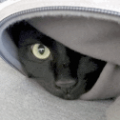Noise blanking and increased noise on waterfall [expected effect]
In an attempt to minimise the effect of the pervasive RFI from the ethernet-over-powerline, I have been playing with the Adio tab's noise blanker, with some limited success (100usec and 70% for my Kiwi at least).
One side effect of this is that the apparent noise floor on the waterfall is raised across all of the spectrum, and the increased noise can also be heard in the audio stream. Is there a known reason for this to happen?
One side effect of this is that the apparent noise floor on the waterfall is raised across all of the spectrum, and the increased noise can also be heard in the audio stream. Is there a known reason for this to happen?

Comments
In the general case of impulse noise blankers the operation is successful under the reasonable assumption that the offending noise impulses will, across the wide spectrum, have a peak energy significantly exceeding that of the average energy, making it easy to detect and trigger. In general this is true for the types of noise for which it was designed such as "spiky" power line discharge, vehicle noise, taking the "edge" of some lightning static, electric fences, etc. where the duration of this strong pulse is very short compared to the audio components of typical received-bandwidths. If the blanking occurs only "rarely" (in terms of the many, many samples of signal taken over a given period of time) the overall energy introduced in the nonlinear action of the blanking will be very low, often being unobservable in a typical HF environment where there are a lot of other noise sources.
When the action of a wideband impulse-type noise blanker - such as the one in the Kiwi (and in many "hardware defined" radios for decades) - is low/moderate, its deletarious affects will be minimal, triggering only on the "occasional", strong signal peaks typical of impulse noise. If the threshold is lowered too much it will trigger on lower-energy impulses - which may include aspects of the background "white" noise intrinsic to HF as well as other signals like modulation peaks of broadcast stations, etc. the effect being that the too-frequent blanking action will increase cause obvious "smearing" of the spectral energy at many frequencies - which is why the noise floor of the receiver is degraded if it is so-adjusted.
In short: The noise blanker is working as it should - and all similar-types of noise blankers, hardware and software, will do the same thing if the threshold is adjusted too "low" and triggers too frequently (although not all radios allow such adjustment.) The key to appropriate adjustment is the best signal/noise ratio of the signal of interest. An impulse-type noise blanker will do nothing to reduce the background "hiss" of the HF spectrum or offending signals that are from coherent signal sources (e.g. the noisy carrier of a switching power supply harmonic) as its action is simply not appropriate for that.
73,
Clint
KA7OEI
More tweaking for me to do then!
-Cathal
Regards,
Martin - G8JNJ